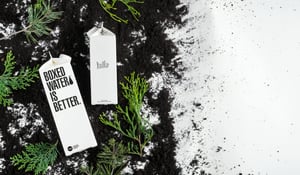We’re in the throes of a sustainability ‘awakening’ driven by consumer demand, increasing regulatory mandates and growing interest in the circular economy (i.e., designing for the recyclability and reuse of materials and products, while minimizing waste).
People around the world are becoming more concerned about sustainability and it’s having a big impact on the packaging world. As consumers vote with their dollars, regulators are following suit with policy – a trend that will only scale upward as millennials and Gen Zs’ preferences for purpose, quality, and novelty continue to influence the way business is done. As a result, corporations are being forced to go beyond the “must-haves” of recyclability and integrate sustainability into their packaging strategy and structure.
Packaging is clutch to the sustainability movement.
.jpg?width=3008&height=2008&name=Untitled%20design%20(14).jpg)
Packaging is a near-trillion-dollar global industry that touches virtually every human being. It impacts everything from reducing product breakage and food waste through the value chain to facilitating consumer convenience.
It also accounts for a large part of a company’s total carbon footprint and carries other environmental costs. The amount of material and energy used in today’s packaging has reached unsustainable levels. Globally, more than 14 million tons of plastic end up in the ocean each year. Containers and packaging make up more than one-fifth of all landfill waste in the U.S. alone. Meanwhile, the production of the sometimes harmful petrochemicals used to make these plastics also continues to rise.
Environmental leaders realize that a new type of packaging is needed to ensure global sustainability—one that reduces the number of materials used, eliminates resource-heavy features such as corrugated boxes and plastic containers and liners, and allows corporations to increase production without increasing waste. Solving for sustainable packaging is an effort both consumers and enterprises want. Globally there’s been a rise in consumers’ willingness to pay more for sustainable packaging and corporate commitments to sustainability, with most of the biggest consumer brands, including Amazon, Walmart, P&G, and others, advocating for making packaging more environmentally friendly.
To solve this global challenge, it’s going to take a combined effort from multiple players in the ecosystem, including venture investors, innovative entrepreneurs, and sustainability-focused corporations.
Thankfully, in the past year, we’ve seen great examples of all three, including:
- Through their new sustainable packaging fund, Pilot44 partner Emerald Technology Ventures invests in early-stage and fast-growing startups propelling advancements in materials and technologies that benefit the planet while driving significant returns. The fund has attracted the likes of industrial and consumer goods companies Beiersdorf, Chevron, Henkel, and Waste Management, which have joined as founding limited partners.
- Startups are working on breakthrough technologies, including sustainable materials and coatings to replace plastic with paper packaging (that performs just as well). This can help in the adoption of a lower carbon circular economy.
- Innovation studios like us (Pilot44) are systematically aligning corporates and startups to create solution pilots focused on driving sustainable innovation at scale. Essentially, this brings together the multi-player ecosystem to bridge gaps in sustainability.
Implementing sustainable packaging is challenging, but help is here.
.jpg?width=2736&height=1824&name=Untitled%20design%20(15).jpg)
Producing environmentally responsible products with minimal impact is trickier than it appears. The lowest carbon material doesn’t always have the highest recyclability or use of recycled content, placing organizations in a performance trade-off where they’re left to decide which aspects of packaging sustainability should be prioritized. It’s important corporations don’t jump in blind.
In response, we partner with Emerald Tech Ventures to help corporations and startups work together to drive change. In this process, Pilot44 works with corporations to articulate their business challenges, match them with the right startups for what they’re looking to solve, and design the best go-to-market strategies.
Pilot44 process in action: Our approach to unlocking sustainability innovation.
Recently, one of our clients, a multinational consumer packaged goods company, partnered with us to find ways to bring new environmentally-friendly sustainable products to market in a fraction of the time and at a fraction of the cost. By following our tried and true innovation process, including Discovery & Design, Build & Launch, Incubate & Grow, we successfully piloted a more convenient solution for their customers that was also more sustainable than their legacy product.
Discovery & Design
- Disruption Sensing: The Pilot44 team delved into the market opportunity to better understand the competitive landscape and map clear benchmarks from market areas ripe for growth. This research helped us identify possible product concepts and key product features – including compostable, natural, plant-based, and recyclable – that ultimately informed the solution ideation.
- Concept Discovery & Design: We used existing client research and new insights from our market research to identify the top 6-8 product innovation ideas. We then analyzed each concept to pinpoint leaders in both sustainability and convenience.
- Concept Prototyping: We conducted flash consumer feedback sessions to refine high-level assumptions about the initial concepts and developed digital prototypes to validate consumer interest and demand. Gathering real, in-market data helped to inform how we prioritized different ideas and determined the ultimate best concept to take forward.
- Business Strategy & Planning: Together with our client, the Pilot44 team developed a full venture pitch for the new solution. The pitch included the key consumer challenge, total addressable market, recommended minimal viable product (MVP), how the MVP would be produced, and an early go-to-market strategy. We also built a detailed cash flow and solution roadmap, which informed the funding needed for the next phase.
Build & Launch
During this phase, we worked with the client’s R&D and manufacturing teams and nimble external partners, including our robust startup ecosystem, to design and manufacture the initial batch of sellable products. Six months after receiving the initial venture design sign-off, we were able to go to market with the MVP.
Incubate & Grow
In this stage, our team obtained comprehensive insights from in-market testing, including product messaging, pricing, repurchase intent (a whopping 90.65%), and detailed consumer feedback on the product itself.
During this incubation and experimentation phase, we achieved an overwhelmingly positive performance, resulting in the product rollout in hundreds of top-retail customer stores and a scaled direct-to-consumer rollout (currently underway).
Check out Part II of Why Sustainable Packaging May Be Your Best Investment Yet to learn how some of the most innovative startups are creating sustainable packaging solutions for corporations worldwide.
Learn more about Pilot44 and our comprehensive ideation to incubation process today.


